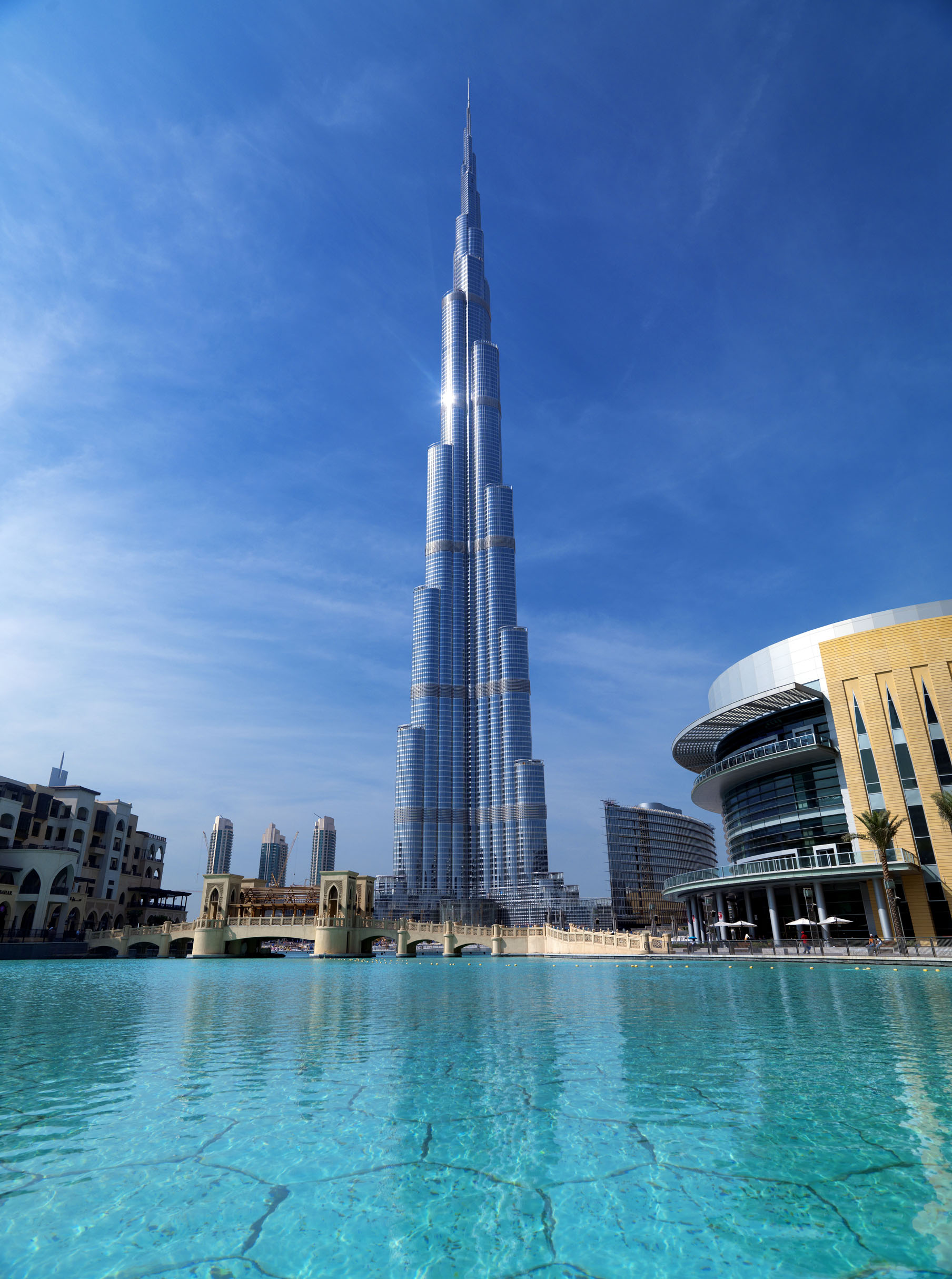The Burj Khalifa is part of an extraordinary 500 acre development called Downtown Dubai. The tower’s design is derived from patterning systems embodied in Islamic architecture, and also takes inspiration from the harmonious structure of the Hymenocallis plant, which is native to the region.
This iconic project breaks many records while overcoming the greatest of challenges and technical difficulties, not least of which are the wind forces dominating the structural design of the tower, the logistics of moving men and materials at extreme heights, and construction of the building envelope.
Addressing the environmental and technical challenges
As with any construction in the Middle East, Dow Corning’s technical experts were confronted with testing and specifying products that are able to withstand the rigors of high temperature, ultra-violet light, seismic activity and inclement weather conditions including sandstorms and high winds. In addition, large areas of the curtain wall, which in total is equivalent in size to 17 soccer fields, are positioned at extreme height, which in turn, brings a new set of technical challenges.
Key Participants
Adrian Smith, Skidmore, Owings & Merrill — Architect
Far East Aluminum, Hong Kong Arabian Aluminum, UAE — Structural Glazing Fabricators
White Aluminum, UAE — Insulating Glass Fabricator
Samsung Engineering & Construction — Main Contractor
Emaar Properties — Developer
Solving the pressure build-up problem
A total of 103,000 square meters of glass was used in the cladding panels, which are incorporated into a total facade area of 132,190 square meters. These advanced cladding panels maximize resistance against heat transmission from the sun and save energy through the use of sophisticated engineering techniques, which include high performance reflective glazing.
The unitized panels were interlocking on site and up to two stories tall. Being positioned at such high elevations, the risk of pressure buildup within the insulating glass units was alleviated through the design specification and Dow Corning 3362 Silicone Insulating Glass Sealant, was used as the secondary perimeter seal. Silicone application was carried out by White Aluminum Enterprise, who is a member of Dow Corning® Quality Bond—an initiative which provides technical training and support, designed to achieve excellence in quality control, quality assurance and standards of workmanship.
Products
Dow Corning 993 Silicone Structural Glazing Sealant
Dow Corning 3362 Silicone Insulating Glass Sealant
Dow Corning 798 Clean and Coldroom Silicone Sealant
In addition, Dow Corning 993 Silicone Structural Glazing Sealant was specified to bring additional secondary support of the insulating glass units, which were mechanically attached to the frame as the primary support. And, for sealing the exclusive bathrooms within the prestigious apartments, Dow Corning 798 Cold and Cleanroom Silicone Sealant was specified.
Click here to view a short animated presentation about how Dow Corning products and support helped Burj Khalifa become a reality.
Or, to learn more about the Dow Corning products featured in this case study, as well as the many other proven materials for the construction industry, please visit us here. To speak to your nearest Dow Corning representative, visit dowcorning.com/ContactUs. +
Related Stories
Laboratories | Jan 28, 2022
3 must-know strategies for developers in today’s life sciences industry
While the life sciences industry had been steadily growing, this growth exploded when the pandemic arrived—and there is no indication that this lightning-fast pace will slow down any time soon.
Cultural Facilities | Jan 27, 2022
Growth in content providers creates new demand for soundstage facilities
Relativity Architects' Partner Tima Bell discusses how the explosion in content providers has outpaced the availability of TV and film production soundstages in North America and Europe.
Sponsored | Webinar | Jan 27, 2022
On-demand webinar: Open plenum design with baffles
With their vast, airy aesthetics, open-plan interiors offer a feel that can inspire and support occupants. But they can also create acoustical challenges that negate the effects of all that beauty. Baffles are an ideal ceiling design solution that address both aesthetics and performance.
Architects | Jan 27, 2022
Gensler’s latest design forecast is also a call to action
The firm urges the AEC industry to take the lead in creating a fairer, cleaner built environment that faces many obstacles.
Architects | Jan 26, 2022
HMC Architects Welcomes New Director of Sustainability
The Sacramento studio of leading national architecture and design firm HMC Architects has announced the appointment of new Director of Sustainability Jennifer Wehling, who joined in December
Market Data | Jan 26, 2022
2022 construction forecast: Healthcare, retail, industrial sectors to lead ‘healthy rebound’ for nonresidential construction
A panel of construction industry economists forecasts 5.4 percent growth for the nonresidential building sector in 2022, and a 6.1 percent bump in 2023.
Sponsored | Steel Buildings | Jan 25, 2022
Structural Game Changer: Winning solution for curved-wall gymnasium design
Sponsored | Steel Buildings | Jan 25, 2022
Multifamily + Hospitality: Benefits of building in long-span composite floor systems
Long-span composite floor systems provide unique advantages in the construction of multi-family and hospitality facilities. This introductory course explains what composite deck is, how it works, what typical composite deck profiles look like and provides guidelines for using composite floor systems. This is a nano unit course.
Sponsored | Reconstruction & Renovation | Jan 25, 2022
Concrete buildings: Effective solutions for restorations and major repairs
Architectural concrete as we know it today was invented in the 19th century. It reached new heights in the U.S. after World War II when mid-century modernism was in vogue, following in the footsteps of a European aesthetic that expressed structure and permanent surfaces through this exposed material. Concrete was treated as a monolithic miracle, waterproof and structurally and visually versatile.
Urban Planning | Jan 25, 2022
Retooling innovation districts for medium-sized cities
This type of development isn’t just about innovation or lab space; and it’s not just universities or research institutions that are driving this change.

















